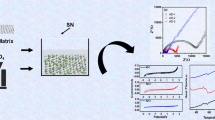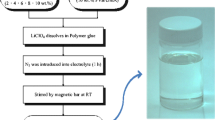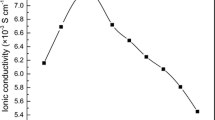Abstract
Poly(ethylene glycol)/poly(2-acrylamido-2-methyl-1-propane sulfonic acid) (PEG/PAMPS) with a transparent appearance were prepared in the presence of ammonium persulfate (APS) as an initiator at 70 °C for 24 h. PEG/PAMPS-based polymer gel electrolytes in a motionless and uniform state were obtained by adding the required amount of liquid electrolytes to a dry PEG/PAMPS polymer. Liquid electrolytes include organic solvents with high boiling points (-1-methyl-2-pyrrolidone (NMP) and γ-butyrolactone (GBL)) and a redox couple (alkali metal iodide salt/iodine). The optimized conditions for PEG/PAMPS-based gel electrolytes based on the salt type, the concentration of alkali metal iodide salt/iodine, and solvent volume ratio were determined to be NaI, 0.4 M NaI/0.04 M I2, and NMP:GBL (7:3, v/v), respectively. The highest ionic conductivity and the liquid electrolyte absorbency were 2.58 mS cm−1 and 3.6 g g−1 at 25 °C, respectively. The ion transport mechanism in both the polymer gel electrolytes and liquid electrolytes is investigated extensively, and their best fits with respect to the temperature dependence of the ionic conductivity are determined with the Arrhenius equation.


















Similar content being viewed by others
References
De Freitas JN, Goncalves ADS, De Paoli M-A, Durrant JR, Nogueira AF (2008) The role of gel electrolyte composition in the kinetics and performance of dye-sensitized solar cells. Electrochim Acta 53(24):7166–7172
Wang Y (2009) Recent research progress on polymer electrolytes for dye-sensitized solar cells. Sol Energy Mater Sol Cells 93(8):1167–1175
Li F, Cheng F, Shi J, Cai F, Liang M, Chen J (2007) Novel quasi-solid electrolyte for dye-sensitized solar cells. J Power Sources 165(2):911–915
Li G, Li Z, Zhang P, Zhang H, Wu Y (2008) Research on a gel polymer electrolyte for Li-ion batteries. Pure Appl Chem 80(11):2553–2563
Stephan AM (2006) Review on gel polymer electrolytes for lithium batteries. Eur Polym J 42:21–42
Sekhon SS, Deepa, Agnihotry SA (2000) Solvent effect on gel electrolytes containing lithium salts. Solid State Ionics 136-137:1189–1192
O’Regan B, Grätzel M (1991) A low-cost, high efficiency solar cell based on dye-sensitized colloidal TiO2 films. Nature 353:737–740
Wang P, Zakeeruddin SM, Moser JE, Nazeeruddin MK, Sekiguchi T, Grätzel M (2003) A stable quasi-solid-state dye-sensitized solar cell with an amphiphilic rythenium sensitizer and polymer gel electrolyte. Nat Mater 2:402–407
Zhao Y, Zhang Y, Gosselink D, Doan TNL, Sadhu M, Cheang H-J, Chen P (2012) Polymer electrolytes for lithium/sulfur batteries. Membranes 2(3):553–564
Saikia D, Han CC, Chen-Yang YW (2008) Influence of polymer concentration and dyes on photovoltaic performance of dye-sensitized solar cell with P(VdF-HFP)-based gel polymer electrolyte. J Power Sources 185(1):570–576
Sekhon SS (2003) Conductivity behaviour of polymer gel electrolytes: role of polymer. Bull Mater Sci 26(3):321–328
Sekhon SS, Arora N, Singh HP (2003) Effect of donor number of solvent on the conductivity behaviour of nonaqueous proton-conducting polymer gel electrolytes. Solid State Ionics 160:301–307
Bella F, Sacco A, Salvador GP, Bianco S, Tresso E, Pirri CF, Bongiovanni R (2013) First pseudohalogen polymer electrolyte for dye-sensitized solar cells promising for in situ photopolymerization. J Phys Chem C 117:20421–20430
Bella F, Imperiyka M, Ahmad A (2014) Photochemically produced quasi-linear copolymers for stable and efficient electrolytes in dye-sensitized solar cells. J Photochem Photobiol A Chem 289:73–80
Wu J, Li P, Hao S, Yang H, Lan Z (2007) A polyblend electrolyte (PVP/PEG + KI + I2) for dye-sensitized nanocrystalline TiO2 solar cells. Electrochim Acta 52:5334–5338
Li PJ, Wu JH, Huang ML, Hao SC, Lan Z, Li Q, Kang S (2007) The application of P(MMA-co-MAA)/PEG polyblend gel electrolyte in quasi-solid state dye-sensitized solar cell at higher temperature. Electrochim Acta 53:903–908
Liu Q, Wu J, Lan Z, Zheng M, Yue G, Lin J, Huang M (2015) Preparation of PAA-g-PEG/PANI polymer gel electrolyte and its application in quasi solid state dye-sensitized solar cells. Polym Eng Sci 55(2):322–326
Song C, Zhang L, Wang Y, Yan X, Zhao D (2013) Synthesis and optimization of P(MMA-BA-MAA)/PEG-based polymer gel electrolytes. J Mater Sci 48(23):8153–8162
Wu J, Lan Z, Lin J, Huang M, Hao S, Sato T, Yin S (2007) A novel thermosetting gel electrolyte for stable quasi-solid-state dye-sensitized solar cells. Adv Mater 19:4006–4011
Cui W-W, Tang D-Y, Gong Z-l, Guo Y-D (2012) Performance enhancement induced by electrospinning of polymer electrolytes based on poly(methyl methacrylate-co-2-acrylamido-2-methylpropanesulfonic acid lithium). J Mater Sci 47:6276–6285
Lan Z, Wu J, Lin J, Huang M, Li P, Li Q (2008) Influence of ionic additives NaI/I2 on the properties of polymer gel electrolyte and performance of quasi-solid-state dye-sensitized solar cells. Electrochim Acta 53(5):2296–2301
Lan Z, Wu J, Wang D, Hao S, Lin J, Huang Y (2006) Quasi-solid state dye-sensitized solar cells based on gel polymer electrolyte with poly(acrylonitrile-co-styrene)/NaI+I2. Sol Energy 80(11):1483–1488
Yang H, Huang M, Wu J, Lan Z, Hao S, Lin J (2008) The polymer gel electrolyte based on poly(methyl methacrylate) and its application in quasi-solid-state dye-sensitized solar cells. Mater Chem Phys 110:38–42
Lan Z, Wu J, Lin J, Huang M (2007) Quasi-solid-state dye-sensitized solar cells with a novel efficient absorbent for liquid electrolyte based on PAA–PEG hybrid. J Power Sources 164:921–925
Lyutov V, Georgiev G, Tsakova V (2009) Comparative study on the electrochemical synthesis of polyaniline in the presence of mono- and poly(2-acrylamido-2-methyl-1-propanesulfonic) acid. Thin Solid Films 517:6681–6688
Wu J, Lan Z, Hao S, Li P, Lin J, Huang M, Fang L, Huang Y (2008) Progress on the electrolytes for dye-sensitized solar cells. Pure Appl Chem 80(11):2241–2258
Sekhon SS, Singh HP (2002) Ionic conductivity of PVdF-based polymer gel electrolytes. Solid State Ionics 152-153:169–174
Wu J, Lan Z, Lin J, Huang M, Li P (2007) Effect of solvents in liquid electrolyte on the photovoltaic performance of dye-sensitized solar cells. J Power Sources 173:585–591
Wu J, Lan Z, Lin J, Huang M, Hao S, Fang L (2007) Influence of solvent on the poly (acrylic acid)-oligo-(ethylene glycol) polymer gel electrolyte and the performance of quasi-solid-state dye-sensitized solar cells. Electrochim Acta 52:7128–7135
Dillon REA, Shriver DF (2000) Influence of cation size on ionic glass formation and ionic conductivity. Solid State Ionics 132:93–99
Vondrák J, Sedlaříková M, Velická J, Klápště B, Novák V, Reiter J (2001) Gel polymer electrolytes based on PMMA. Electrochim Acta 46:2047–2048
Haynes WM (Editor-in-Chief), 2012–2013, 93RD Edition CRC Handbook of Chemistry and Physics, CRC Press Taylor&Francis Group, Boca Raton, FL. USA International Standard Book Number: 978–1-4398-8049-4 (Hardback)
Stathatos E, Lianos P, Vuk AS, Orel B (2004) Optimization of a quasi-solid-state dye-sensitized photoelectrochemical solar cell employing a ureasil/sulfolane gel electrolyte. Adv Funct Mater 14(1):45–48
Orel B, Vuk AS, Ješe R, Lianos P, Stathatos E, Judeinstein P, Colomban Ph (2003) Development of sol–gel redox I3 −/I− electrolytes and their application in hybrid electrochromic devices. Solid State Ionics 165:235–246
Deepa M, Sharma N, Agnihotry SA, Singh S, Lal T, Chandra R (2002) Conductivity and viscosity of liquid and gel electrolytes based on LiClO4, LiN(CF3SO2)2 and PMMA. Solid State Ionics 152-153:253–258
Shi J, Peng S, Pei J, Liang Y, Cheng F, Chen J (2009) Quasi-solid-state dye-sensitized solar cells with polymer gel electrolyte and triphenylamine-based organic dyes. ACS Applied Materials&Interfaces 1(4):944–950
Li Q, Wu J, Tang Q, Lan Z, Li P, Zhang T (2009) Application of polymer gel electrolyte with graphite powder in quasi-solid-state dye-sensitized solar cells. Polym Composite 30(11):1687–1692
Yu B, Zhou F, Wang C, Liu W (2007) A novel gel polymer electrolyte based on poly ionic liquid 1-ethyl 3-(2-methacryloyloxy ethyl) imidazolium iodide. Eur Polym J 43:2699–2707
Kabiri K, Lashani S, Zohuriaan-Mehr MJ, Kheirabadi M (2011) Super alcohol-absorbent gels of sulfonic acid-contained poly(acrylic acid). J Polym Res 18:449–458
Imperiyka M, Ahmad A, Hanifah SA, Mohamed NS, Rahman MYA (2014) Investigation of plasticized UV-curable glycidyl methacrylate based solid polymer electrolyte for photoelectrochemical cell (PEC) application. Int J Hydrogen Energ 39:3018–3024
Wu J, Hao S, Lan Z, Lin J, Huang M, Huang Y, Fang L, Yin S, Sato T (2007) A thermoplastic gel electrolyte for stable quasi-solid-state dye-sensitized solar cells. Adv Funct Mater 17:2645–2652
Mansur HS, Oréfice RL, Mansur AAP (2004) Characterization of poly(vinyl alcohol)/poly(ethylene glycol) hydrogels and PVA-derived hybrids by small-angle X-ray scattering and FTIR spectroscopy. Polymer 45:7193–7202
Qiao J, Hamaya T, Okada T (2005) New highly proton-conducting membrane poly(vinylpyrrolidone)(PVP) modified poly(vinyl alcohol)/2-acrylamido-2-methyl-1-propanesulfonic acid (PVA–PAMPS) for low temperature direct methanol fuel cells (DMFCs). Polymer 46:10809–10816
Reddy MJ, Kumar JS, Rao UVS, Chu PP (2006) Structural and ionic conductivity of PEO blend PEG solid polymer electrolyte. Solid State Ionics 177:253–256
Çavuş S (2010) Poly(methacrylamide-co-2-acrylamido-2-methyl-1-propanesulfonic acid) hydrogels: investigation of pH- and temperature-dependent swelling characteristics and their characterization. J Polym Sci B Polym Phys 48:2497–2508
Shen X, Xu W, Xu J, Liang G, Yang H, Yao M (2008) Quasi-solid-state dye-sensitized solar cells based on gel electrolytes containing different alkali metal iodide salts. Solid State Ionics 179:2027–2030
Lan Z, Wu J, Lin J, Huang M, Yin S, Sato T (2007) Influence of molecular weight of PEG on the property of polymer gel electrolyte and performance of quasi-solid-state dye-sensitized solar cells. Electrochim Acta 52:6673–6678
Kebede Z, Lindquist S-E (1999) Donor–acceptor interaction between non-aqueous solvents and I2 to generate I3 −, and its implication in dye sensitized solar cells. Sol Energy Mater Sol Cells 57:259–275
Acknowledgments
This study was supported by a research fund of Istanbul University with project nos. 27915 and 33168.
Author information
Authors and Affiliations
Corresponding author
Additional information
▪This study provides a useful approach to prepare and characterize polymer gel electrolytes based on the strong acidic monomer 2-acrylamido-2-methyl-1-propane sulfonic acid (AMPS).
▪Among the different salts studied, NaI indicates the best performance on the ionic conductivity and liquid electrolyte absorbency of polymer gel electrolytes.
▪The highest ionic conductivity of the PEG/PAMPS-based polymer gel electrolytes is 2.58 mS cm−1 at room temperature.
▪The ionic conductivity mechanism follows the Arrhenius relationship.
▪The amorphous state plays an important role to improve ionic conductivity, and the amorphous property of the polymer gel electrolytes is confirmed by characterization studies.
▪A positive effect of PAMPS on amorphous structures is observed.
Rights and permissions
About this article
Cite this article
Çavuş, S., Yıldıran, M. Poly(ethylene glycol)/poly(2-acrylamido-2-methyl-1-propane sulfonic acid) gel electrolytes: a detailed investigation of their conductivity and characterization. Ionics 22, 1059–1073 (2016). https://doi.org/10.1007/s11581-016-1649-6
Received:
Revised:
Accepted:
Published:
Issue Date:
DOI: https://doi.org/10.1007/s11581-016-1649-6




